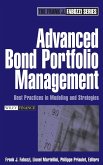Moorad Choudhry
An Introduction to Bond Markets
Moorad Choudhry
An Introduction to Bond Markets
- Broschiertes Buch
- Merkliste
- Auf die Merkliste
- Bewerten Bewerten
- Teilen
- Produkt teilen
- Produkterinnerung
- Produkterinnerung
Introduction to Bond Markets provides a comprehensive, authoritative description of the bond markets. The contents describe and define bonds within the context of the capital markets and the different types of bonds that are traded. The Fourth Edition has been completely updated to reflect the many changes in the industry as a result of the financial crisis. In addition, four new chapters feature the causes of the financial crisis and the implications for bond investors, risk, return and diversification, securitization, and credit derivatives. Ideal for traders, fund managers, and students in the field.…mehr
Andere Kunden interessierten sich auch für
![Advanced Bond Portfolio Management Advanced Bond Portfolio Management]() Frank J. FabozziAdvanced Bond Portfolio Management87,99 €
Frank J. FabozziAdvanced Bond Portfolio Management87,99 €![Duration, Convexity, and Other Bond Risk Measures Duration, Convexity, and Other Bond Risk Measures]() Frank J. FabozziDuration, Convexity, and Other Bond Risk Measures91,99 €
Frank J. FabozziDuration, Convexity, and Other Bond Risk Measures91,99 €![The Futures Bond Basis The Futures Bond Basis]() Moorad ChoudhryThe Futures Bond Basis47,99 €
Moorad ChoudhryThe Futures Bond Basis47,99 €![Interest and Bond Values Interest and Bond Values]() Michael Alexander MackenzieInterest and Bond Values34,99 €
Michael Alexander MackenzieInterest and Bond Values34,99 €![Managing a Corporate Bond Portfolio Managing a Corporate Bond Portfolio]() Leland E. CrabbeManaging a Corporate Bond Portfolio91,99 €
Leland E. CrabbeManaging a Corporate Bond Portfolio91,99 €![Bond Offerings; Volume 8 Bond Offerings; Volume 8]() Roger Ward BabsonBond Offerings; Volume 842,99 €
Roger Ward BabsonBond Offerings; Volume 842,99 €![The Investment Industry for It Practitioners The Investment Industry for It Practitioners]() Andrew BradfordThe Investment Industry for It Practitioners80,99 €
Andrew BradfordThe Investment Industry for It Practitioners80,99 €-
-
-
Introduction to Bond Markets provides a comprehensive, authoritative description of the bond markets. The contents describe and define bonds within the context of the capital markets and the different types of bonds that are traded. The Fourth Edition has been completely updated to reflect the many changes in the industry as a result of the financial crisis. In addition, four new chapters feature the causes of the financial crisis and the implications for bond investors, risk, return and diversification, securitization, and credit derivatives. Ideal for traders, fund managers, and students in the field.
Hinweis: Dieser Artikel kann nur an eine deutsche Lieferadresse ausgeliefert werden.
Hinweis: Dieser Artikel kann nur an eine deutsche Lieferadresse ausgeliefert werden.
Produktdetails
- Produktdetails
- Securities and Investment Institute
- Verlag: Wiley & Sons
- Artikelnr. des Verlages: 14568724000
- 4. Aufl.
- Seitenzahl: 480
- Erscheinungstermin: 18. Oktober 2010
- Englisch
- Abmessung: 229mm x 152mm x 26mm
- Gewicht: 690g
- ISBN-13: 9780470687246
- ISBN-10: 047068724X
- Artikelnr.: 29985404
- Herstellerkennzeichnung
- Libri GmbH
- Europaallee 1
- 36244 Bad Hersfeld
- gpsr@libri.de
- Securities and Investment Institute
- Verlag: Wiley & Sons
- Artikelnr. des Verlages: 14568724000
- 4. Aufl.
- Seitenzahl: 480
- Erscheinungstermin: 18. Oktober 2010
- Englisch
- Abmessung: 229mm x 152mm x 26mm
- Gewicht: 690g
- ISBN-13: 9780470687246
- ISBN-10: 047068724X
- Artikelnr.: 29985404
- Herstellerkennzeichnung
- Libri GmbH
- Europaallee 1
- 36244 Bad Hersfeld
- gpsr@libri.de
Dr Moorad Choudhry is the former Head of Treasury at Europe Arab Bank plc in London. He is Visiting Professor at the Department of Economics, London Metropolitan University, a Visiting Research Fellow at the ICMA Centre, University of Reading, a Fellow of the ifs-School of Finance and a Fellow of the Chartered Institute for Securities and Investment.
Foreword xvii
Preface xix
Preface to the First Edition xxiii
About the author xxv
1 Introduction to Bonds 1
Description 4
Outline of market participants 6
Bond analysis 8
Financial arithmetic: the time value of money 8
Present value and discounting 9
Discount factors and boot-strapping the discount function 15
Bond pricing and yield: the traditional approach 18
Bond pricing 18
Bond yield 23
Accrued interest 30
Clean and dirty bond prices 30
Day-count conventions 32
Illustrating bond yield using Excel spreadsheets 33
Bibliography 38
2 The Yield Curve, Spot and Forward Yields 41
The yield curve 42
Yield-to-maturity yield curve 42
The par yield curve 44
The zero-coupon (or spot) yield curve 45
The forward yield curve 49
Theories of the yield curve 50
Spot rates 54
Discount factors and the discount function 55
The boot-strapping method: deriving the theoretical zero-coupon (spot) rate
curve 56
Mathematical relationship 60
Implied forward rates 62
Understanding forward rates 69
The term structure of interest rates 70
Bibliography 73
3 Bond Instruments and Interest-rate Risk 75
Duration, modified duration and convexity 76
Duration 77
Properties of Macaulay duration 81
Modified duration 81
Convexity 87
Bibliography 91
4 Floating-rate Notes and other Bond Instruments 93
Floating-rate notes 94
Synthetic convertible note 98
Description 98
Investor benefits 99
Interest differential notes 99
Example of IDN 99
Benefits to investors 100
Convertible quanto note 101
Example of Japanese equity note 102
Bibliography 105
5 The Money Markets 107
Introduction 109
Securities quoted on a yield basis 111
Money market deposits 111
Certificates of deposit 113
cd yields 114
Securities quoted on a discount basis 118
Treasury bills 120
Banker's acceptances 121
Eligible banker's acceptance 122
Commercial paper 123
Commercial paper programmes 124
Commercial paper yields 126
Asset-backed commercial paper 127
Repo 132
Definition 133
The classic repo 134
Examples of classic repo 136
The sell/buy-back 141
Examples of sell/buy-back 142
Repo collateral 144
Legal treatment 146
Margin 146
Variation margin 148
5.A Currencies using money market year base of 365 days 148
6 the Eurobond Market 151
Eurobonds 152
Foreign bonds 155
Eurobond instruments 155
Conventional bonds 155
Floating rate notes 156
Zero-coupon bonds 157
Convertible bonds 157
The issue process: market participants 159
The borrowing parties 160
The underwriting lead manager 162
The co-lead manager 163
Investors 164
Fees, expenses and pricing 164
Fees 164
Expenses 165
Pricing 165
Issuing the bond 166
The grey market 168
Alternative issue procedures 168
Covenants 169
Trust services 170
Depositary 170
Paying agent 171
Registrar 172
Trustee 172
Custodian 173
Form of the bond 173
Temporary global form 173
Permanent global bond 174
Definitive form 174
Registered bonds 175
Fiscal agent 176
Listing agent 176
Clearing systems 176
Market associations 178
International Capital Market Association 178
Bloomberg screens 178
Secondary market 180
Settlement 180
Bibliography 181
7 CONVERTIBLE BONDS, MTNs AND WARRANTS 183
Description 184
Analysis 184
Value and premium issues 187
Zero-coupon convertibles 188
Warrants 189
Medium-term notes 190
MTN programme 191
Shelf registration 192
Credit rating 192
Secondary market 192
Issuers and investors 193
MTNs and corporate bonds 193
8 Credit Ratings 197
Credit ratings 199
Purpose of credit ratings 199
Formal credit ratings 200
Credit rating agencies and the 2007-2008 financial market crash 201
9 Inflation-linked Bonds 209
Basic concepts 210
Choice of index 210
Indexation lag 211
Coupon frequency 213
Type of indexation 213
Index-linked bond cash flows and yields 215
TIPS cash flow calculations 216
TIPS price and yield calculations 217
Assessing yields on index-linked bonds 220
Which to hold: indexed or conventional bonds? 221
Inflation-indexed derivatives 222
Market instruments 223
Applications 227
Bibliography 228
10 An Introduction to Asset-backed Securities 229
The concept of securitisation 232
Reasons for undertaking securitisation 233
Benefits of securitisation to investors 236
The process of securitisation 237
Securitisation process 237
SPV structures 239
Credit enhancement 240
Impact on balance sheet 242
Credit rating 243
Redemption mechanism 245
Average life 245
Illustrating the process of securitisation 246
Securitisation post-credit crunch 250
Bloomberg screens 253
Bibliography 259
11 Introduction to Derivative Instruments 261
Interest-rate swaps 262
Characteristics of IR swaps 264
Swap spreads and the swap yield curve 267
Swap duration 270
Summary of IR swap 271
Non-standard swaps 271
Using swaps 273
Cancelling a swap 276
Zero-coupon swap pricing 276
Hedging using bonds and swaps 278
Swaptions 282
Cross-currency swaps 283
Bloomberg screens 284
Futures contracts 288
Description 288
Bond futures contracts 290
Futures pricing 293
Arbitrage-free futures pricing 297
Hedging using futures 299
The hedge ratio 301
Interest-rate options 302
Introduction 302
Definition 303
Option terminology 305
Option premium 306
Pricing options 307
Behaviour of option prices 311
Using options in bond markets 312
Hedging using bond options 314
Exotic options 315
Bibliography 317
12 Introduction to Credit Derivatives 319
Introduction 321
Why use credit derivatives? 323
Classification of credit derivative instruments 325
Definition of a credit event 326
Asset swaps 327
Credit default swaps 330
Impact of the 2007-2008 credit crunch: new CDS contracts and the CDS 'Big
Bang' 334
Credit-linked notes 338
Total return swaps 341
Synthetic repo 345
Reduction in credit risk 346
Capital structure arbitrage 347
The TRS as a funding instrument 347
Credit options 349
The CDS iTraxx index 350
General applications of credit derivatives 355
Use of credit derivatives by portfolio managers 355
The credit default swap basis 358
A negative basis 358
The basis as market indicator 361
Bibliography 364
13 Approaches to Government Bond Trading And Yield Analysis 365
Introduction 366
The determinants of yield 366
Spread trade risk weighting 367
Identifying yield spread trades 373
Coupon spreads 374
Butterfly trades 376
Basic concepts 376
Putting on the trade 377
Yield gain 379
Convexity gain 380
Bloomberg screens 384
Bond spreads and relative value 386
Bond spreads 388
Summary of a fund manager's approach to value creation 393
Bibliography 396
14 Risk Management and Value-at-risk 397
Characterising risk 398
Risk management 400
The risk management function 401
Interest-rate risk 402
Value-at-Risk 403
Definition 403
Calculation methods 404
Validity of the variance-covariance (correlation) VaR estimate 406
Assessment of VaR tool 407
VaR methodology for credit risk 408
Modelling VaR for credit risk 409
Time horizon 411
Applications of credit VaR 412
Bibliography 412
Glossary 413
List of abbreviations 421
Index 425
Preface xix
Preface to the First Edition xxiii
About the author xxv
1 Introduction to Bonds 1
Description 4
Outline of market participants 6
Bond analysis 8
Financial arithmetic: the time value of money 8
Present value and discounting 9
Discount factors and boot-strapping the discount function 15
Bond pricing and yield: the traditional approach 18
Bond pricing 18
Bond yield 23
Accrued interest 30
Clean and dirty bond prices 30
Day-count conventions 32
Illustrating bond yield using Excel spreadsheets 33
Bibliography 38
2 The Yield Curve, Spot and Forward Yields 41
The yield curve 42
Yield-to-maturity yield curve 42
The par yield curve 44
The zero-coupon (or spot) yield curve 45
The forward yield curve 49
Theories of the yield curve 50
Spot rates 54
Discount factors and the discount function 55
The boot-strapping method: deriving the theoretical zero-coupon (spot) rate
curve 56
Mathematical relationship 60
Implied forward rates 62
Understanding forward rates 69
The term structure of interest rates 70
Bibliography 73
3 Bond Instruments and Interest-rate Risk 75
Duration, modified duration and convexity 76
Duration 77
Properties of Macaulay duration 81
Modified duration 81
Convexity 87
Bibliography 91
4 Floating-rate Notes and other Bond Instruments 93
Floating-rate notes 94
Synthetic convertible note 98
Description 98
Investor benefits 99
Interest differential notes 99
Example of IDN 99
Benefits to investors 100
Convertible quanto note 101
Example of Japanese equity note 102
Bibliography 105
5 The Money Markets 107
Introduction 109
Securities quoted on a yield basis 111
Money market deposits 111
Certificates of deposit 113
cd yields 114
Securities quoted on a discount basis 118
Treasury bills 120
Banker's acceptances 121
Eligible banker's acceptance 122
Commercial paper 123
Commercial paper programmes 124
Commercial paper yields 126
Asset-backed commercial paper 127
Repo 132
Definition 133
The classic repo 134
Examples of classic repo 136
The sell/buy-back 141
Examples of sell/buy-back 142
Repo collateral 144
Legal treatment 146
Margin 146
Variation margin 148
5.A Currencies using money market year base of 365 days 148
6 the Eurobond Market 151
Eurobonds 152
Foreign bonds 155
Eurobond instruments 155
Conventional bonds 155
Floating rate notes 156
Zero-coupon bonds 157
Convertible bonds 157
The issue process: market participants 159
The borrowing parties 160
The underwriting lead manager 162
The co-lead manager 163
Investors 164
Fees, expenses and pricing 164
Fees 164
Expenses 165
Pricing 165
Issuing the bond 166
The grey market 168
Alternative issue procedures 168
Covenants 169
Trust services 170
Depositary 170
Paying agent 171
Registrar 172
Trustee 172
Custodian 173
Form of the bond 173
Temporary global form 173
Permanent global bond 174
Definitive form 174
Registered bonds 175
Fiscal agent 176
Listing agent 176
Clearing systems 176
Market associations 178
International Capital Market Association 178
Bloomberg screens 178
Secondary market 180
Settlement 180
Bibliography 181
7 CONVERTIBLE BONDS, MTNs AND WARRANTS 183
Description 184
Analysis 184
Value and premium issues 187
Zero-coupon convertibles 188
Warrants 189
Medium-term notes 190
MTN programme 191
Shelf registration 192
Credit rating 192
Secondary market 192
Issuers and investors 193
MTNs and corporate bonds 193
8 Credit Ratings 197
Credit ratings 199
Purpose of credit ratings 199
Formal credit ratings 200
Credit rating agencies and the 2007-2008 financial market crash 201
9 Inflation-linked Bonds 209
Basic concepts 210
Choice of index 210
Indexation lag 211
Coupon frequency 213
Type of indexation 213
Index-linked bond cash flows and yields 215
TIPS cash flow calculations 216
TIPS price and yield calculations 217
Assessing yields on index-linked bonds 220
Which to hold: indexed or conventional bonds? 221
Inflation-indexed derivatives 222
Market instruments 223
Applications 227
Bibliography 228
10 An Introduction to Asset-backed Securities 229
The concept of securitisation 232
Reasons for undertaking securitisation 233
Benefits of securitisation to investors 236
The process of securitisation 237
Securitisation process 237
SPV structures 239
Credit enhancement 240
Impact on balance sheet 242
Credit rating 243
Redemption mechanism 245
Average life 245
Illustrating the process of securitisation 246
Securitisation post-credit crunch 250
Bloomberg screens 253
Bibliography 259
11 Introduction to Derivative Instruments 261
Interest-rate swaps 262
Characteristics of IR swaps 264
Swap spreads and the swap yield curve 267
Swap duration 270
Summary of IR swap 271
Non-standard swaps 271
Using swaps 273
Cancelling a swap 276
Zero-coupon swap pricing 276
Hedging using bonds and swaps 278
Swaptions 282
Cross-currency swaps 283
Bloomberg screens 284
Futures contracts 288
Description 288
Bond futures contracts 290
Futures pricing 293
Arbitrage-free futures pricing 297
Hedging using futures 299
The hedge ratio 301
Interest-rate options 302
Introduction 302
Definition 303
Option terminology 305
Option premium 306
Pricing options 307
Behaviour of option prices 311
Using options in bond markets 312
Hedging using bond options 314
Exotic options 315
Bibliography 317
12 Introduction to Credit Derivatives 319
Introduction 321
Why use credit derivatives? 323
Classification of credit derivative instruments 325
Definition of a credit event 326
Asset swaps 327
Credit default swaps 330
Impact of the 2007-2008 credit crunch: new CDS contracts and the CDS 'Big
Bang' 334
Credit-linked notes 338
Total return swaps 341
Synthetic repo 345
Reduction in credit risk 346
Capital structure arbitrage 347
The TRS as a funding instrument 347
Credit options 349
The CDS iTraxx index 350
General applications of credit derivatives 355
Use of credit derivatives by portfolio managers 355
The credit default swap basis 358
A negative basis 358
The basis as market indicator 361
Bibliography 364
13 Approaches to Government Bond Trading And Yield Analysis 365
Introduction 366
The determinants of yield 366
Spread trade risk weighting 367
Identifying yield spread trades 373
Coupon spreads 374
Butterfly trades 376
Basic concepts 376
Putting on the trade 377
Yield gain 379
Convexity gain 380
Bloomberg screens 384
Bond spreads and relative value 386
Bond spreads 388
Summary of a fund manager's approach to value creation 393
Bibliography 396
14 Risk Management and Value-at-risk 397
Characterising risk 398
Risk management 400
The risk management function 401
Interest-rate risk 402
Value-at-Risk 403
Definition 403
Calculation methods 404
Validity of the variance-covariance (correlation) VaR estimate 406
Assessment of VaR tool 407
VaR methodology for credit risk 408
Modelling VaR for credit risk 409
Time horizon 411
Applications of credit VaR 412
Bibliography 412
Glossary 413
List of abbreviations 421
Index 425
Foreword xvii
Preface xix
Preface to the First Edition xxiii
About the author xxv
1 Introduction to Bonds 1
Description 4
Outline of market participants 6
Bond analysis 8
Financial arithmetic: the time value of money 8
Present value and discounting 9
Discount factors and boot-strapping the discount function 15
Bond pricing and yield: the traditional approach 18
Bond pricing 18
Bond yield 23
Accrued interest 30
Clean and dirty bond prices 30
Day-count conventions 32
Illustrating bond yield using Excel spreadsheets 33
Bibliography 38
2 The Yield Curve, Spot and Forward Yields 41
The yield curve 42
Yield-to-maturity yield curve 42
The par yield curve 44
The zero-coupon (or spot) yield curve 45
The forward yield curve 49
Theories of the yield curve 50
Spot rates 54
Discount factors and the discount function 55
The boot-strapping method: deriving the theoretical zero-coupon (spot) rate
curve 56
Mathematical relationship 60
Implied forward rates 62
Understanding forward rates 69
The term structure of interest rates 70
Bibliography 73
3 Bond Instruments and Interest-rate Risk 75
Duration, modified duration and convexity 76
Duration 77
Properties of Macaulay duration 81
Modified duration 81
Convexity 87
Bibliography 91
4 Floating-rate Notes and other Bond Instruments 93
Floating-rate notes 94
Synthetic convertible note 98
Description 98
Investor benefits 99
Interest differential notes 99
Example of IDN 99
Benefits to investors 100
Convertible quanto note 101
Example of Japanese equity note 102
Bibliography 105
5 The Money Markets 107
Introduction 109
Securities quoted on a yield basis 111
Money market deposits 111
Certificates of deposit 113
cd yields 114
Securities quoted on a discount basis 118
Treasury bills 120
Banker's acceptances 121
Eligible banker's acceptance 122
Commercial paper 123
Commercial paper programmes 124
Commercial paper yields 126
Asset-backed commercial paper 127
Repo 132
Definition 133
The classic repo 134
Examples of classic repo 136
The sell/buy-back 141
Examples of sell/buy-back 142
Repo collateral 144
Legal treatment 146
Margin 146
Variation margin 148
5.A Currencies using money market year base of 365 days 148
6 the Eurobond Market 151
Eurobonds 152
Foreign bonds 155
Eurobond instruments 155
Conventional bonds 155
Floating rate notes 156
Zero-coupon bonds 157
Convertible bonds 157
The issue process: market participants 159
The borrowing parties 160
The underwriting lead manager 162
The co-lead manager 163
Investors 164
Fees, expenses and pricing 164
Fees 164
Expenses 165
Pricing 165
Issuing the bond 166
The grey market 168
Alternative issue procedures 168
Covenants 169
Trust services 170
Depositary 170
Paying agent 171
Registrar 172
Trustee 172
Custodian 173
Form of the bond 173
Temporary global form 173
Permanent global bond 174
Definitive form 174
Registered bonds 175
Fiscal agent 176
Listing agent 176
Clearing systems 176
Market associations 178
International Capital Market Association 178
Bloomberg screens 178
Secondary market 180
Settlement 180
Bibliography 181
7 CONVERTIBLE BONDS, MTNs AND WARRANTS 183
Description 184
Analysis 184
Value and premium issues 187
Zero-coupon convertibles 188
Warrants 189
Medium-term notes 190
MTN programme 191
Shelf registration 192
Credit rating 192
Secondary market 192
Issuers and investors 193
MTNs and corporate bonds 193
8 Credit Ratings 197
Credit ratings 199
Purpose of credit ratings 199
Formal credit ratings 200
Credit rating agencies and the 2007-2008 financial market crash 201
9 Inflation-linked Bonds 209
Basic concepts 210
Choice of index 210
Indexation lag 211
Coupon frequency 213
Type of indexation 213
Index-linked bond cash flows and yields 215
TIPS cash flow calculations 216
TIPS price and yield calculations 217
Assessing yields on index-linked bonds 220
Which to hold: indexed or conventional bonds? 221
Inflation-indexed derivatives 222
Market instruments 223
Applications 227
Bibliography 228
10 An Introduction to Asset-backed Securities 229
The concept of securitisation 232
Reasons for undertaking securitisation 233
Benefits of securitisation to investors 236
The process of securitisation 237
Securitisation process 237
SPV structures 239
Credit enhancement 240
Impact on balance sheet 242
Credit rating 243
Redemption mechanism 245
Average life 245
Illustrating the process of securitisation 246
Securitisation post-credit crunch 250
Bloomberg screens 253
Bibliography 259
11 Introduction to Derivative Instruments 261
Interest-rate swaps 262
Characteristics of IR swaps 264
Swap spreads and the swap yield curve 267
Swap duration 270
Summary of IR swap 271
Non-standard swaps 271
Using swaps 273
Cancelling a swap 276
Zero-coupon swap pricing 276
Hedging using bonds and swaps 278
Swaptions 282
Cross-currency swaps 283
Bloomberg screens 284
Futures contracts 288
Description 288
Bond futures contracts 290
Futures pricing 293
Arbitrage-free futures pricing 297
Hedging using futures 299
The hedge ratio 301
Interest-rate options 302
Introduction 302
Definition 303
Option terminology 305
Option premium 306
Pricing options 307
Behaviour of option prices 311
Using options in bond markets 312
Hedging using bond options 314
Exotic options 315
Bibliography 317
12 Introduction to Credit Derivatives 319
Introduction 321
Why use credit derivatives? 323
Classification of credit derivative instruments 325
Definition of a credit event 326
Asset swaps 327
Credit default swaps 330
Impact of the 2007-2008 credit crunch: new CDS contracts and the CDS 'Big
Bang' 334
Credit-linked notes 338
Total return swaps 341
Synthetic repo 345
Reduction in credit risk 346
Capital structure arbitrage 347
The TRS as a funding instrument 347
Credit options 349
The CDS iTraxx index 350
General applications of credit derivatives 355
Use of credit derivatives by portfolio managers 355
The credit default swap basis 358
A negative basis 358
The basis as market indicator 361
Bibliography 364
13 Approaches to Government Bond Trading And Yield Analysis 365
Introduction 366
The determinants of yield 366
Spread trade risk weighting 367
Identifying yield spread trades 373
Coupon spreads 374
Butterfly trades 376
Basic concepts 376
Putting on the trade 377
Yield gain 379
Convexity gain 380
Bloomberg screens 384
Bond spreads and relative value 386
Bond spreads 388
Summary of a fund manager's approach to value creation 393
Bibliography 396
14 Risk Management and Value-at-risk 397
Characterising risk 398
Risk management 400
The risk management function 401
Interest-rate risk 402
Value-at-Risk 403
Definition 403
Calculation methods 404
Validity of the variance-covariance (correlation) VaR estimate 406
Assessment of VaR tool 407
VaR methodology for credit risk 408
Modelling VaR for credit risk 409
Time horizon 411
Applications of credit VaR 412
Bibliography 412
Glossary 413
List of abbreviations 421
Index 425
Preface xix
Preface to the First Edition xxiii
About the author xxv
1 Introduction to Bonds 1
Description 4
Outline of market participants 6
Bond analysis 8
Financial arithmetic: the time value of money 8
Present value and discounting 9
Discount factors and boot-strapping the discount function 15
Bond pricing and yield: the traditional approach 18
Bond pricing 18
Bond yield 23
Accrued interest 30
Clean and dirty bond prices 30
Day-count conventions 32
Illustrating bond yield using Excel spreadsheets 33
Bibliography 38
2 The Yield Curve, Spot and Forward Yields 41
The yield curve 42
Yield-to-maturity yield curve 42
The par yield curve 44
The zero-coupon (or spot) yield curve 45
The forward yield curve 49
Theories of the yield curve 50
Spot rates 54
Discount factors and the discount function 55
The boot-strapping method: deriving the theoretical zero-coupon (spot) rate
curve 56
Mathematical relationship 60
Implied forward rates 62
Understanding forward rates 69
The term structure of interest rates 70
Bibliography 73
3 Bond Instruments and Interest-rate Risk 75
Duration, modified duration and convexity 76
Duration 77
Properties of Macaulay duration 81
Modified duration 81
Convexity 87
Bibliography 91
4 Floating-rate Notes and other Bond Instruments 93
Floating-rate notes 94
Synthetic convertible note 98
Description 98
Investor benefits 99
Interest differential notes 99
Example of IDN 99
Benefits to investors 100
Convertible quanto note 101
Example of Japanese equity note 102
Bibliography 105
5 The Money Markets 107
Introduction 109
Securities quoted on a yield basis 111
Money market deposits 111
Certificates of deposit 113
cd yields 114
Securities quoted on a discount basis 118
Treasury bills 120
Banker's acceptances 121
Eligible banker's acceptance 122
Commercial paper 123
Commercial paper programmes 124
Commercial paper yields 126
Asset-backed commercial paper 127
Repo 132
Definition 133
The classic repo 134
Examples of classic repo 136
The sell/buy-back 141
Examples of sell/buy-back 142
Repo collateral 144
Legal treatment 146
Margin 146
Variation margin 148
5.A Currencies using money market year base of 365 days 148
6 the Eurobond Market 151
Eurobonds 152
Foreign bonds 155
Eurobond instruments 155
Conventional bonds 155
Floating rate notes 156
Zero-coupon bonds 157
Convertible bonds 157
The issue process: market participants 159
The borrowing parties 160
The underwriting lead manager 162
The co-lead manager 163
Investors 164
Fees, expenses and pricing 164
Fees 164
Expenses 165
Pricing 165
Issuing the bond 166
The grey market 168
Alternative issue procedures 168
Covenants 169
Trust services 170
Depositary 170
Paying agent 171
Registrar 172
Trustee 172
Custodian 173
Form of the bond 173
Temporary global form 173
Permanent global bond 174
Definitive form 174
Registered bonds 175
Fiscal agent 176
Listing agent 176
Clearing systems 176
Market associations 178
International Capital Market Association 178
Bloomberg screens 178
Secondary market 180
Settlement 180
Bibliography 181
7 CONVERTIBLE BONDS, MTNs AND WARRANTS 183
Description 184
Analysis 184
Value and premium issues 187
Zero-coupon convertibles 188
Warrants 189
Medium-term notes 190
MTN programme 191
Shelf registration 192
Credit rating 192
Secondary market 192
Issuers and investors 193
MTNs and corporate bonds 193
8 Credit Ratings 197
Credit ratings 199
Purpose of credit ratings 199
Formal credit ratings 200
Credit rating agencies and the 2007-2008 financial market crash 201
9 Inflation-linked Bonds 209
Basic concepts 210
Choice of index 210
Indexation lag 211
Coupon frequency 213
Type of indexation 213
Index-linked bond cash flows and yields 215
TIPS cash flow calculations 216
TIPS price and yield calculations 217
Assessing yields on index-linked bonds 220
Which to hold: indexed or conventional bonds? 221
Inflation-indexed derivatives 222
Market instruments 223
Applications 227
Bibliography 228
10 An Introduction to Asset-backed Securities 229
The concept of securitisation 232
Reasons for undertaking securitisation 233
Benefits of securitisation to investors 236
The process of securitisation 237
Securitisation process 237
SPV structures 239
Credit enhancement 240
Impact on balance sheet 242
Credit rating 243
Redemption mechanism 245
Average life 245
Illustrating the process of securitisation 246
Securitisation post-credit crunch 250
Bloomberg screens 253
Bibliography 259
11 Introduction to Derivative Instruments 261
Interest-rate swaps 262
Characteristics of IR swaps 264
Swap spreads and the swap yield curve 267
Swap duration 270
Summary of IR swap 271
Non-standard swaps 271
Using swaps 273
Cancelling a swap 276
Zero-coupon swap pricing 276
Hedging using bonds and swaps 278
Swaptions 282
Cross-currency swaps 283
Bloomberg screens 284
Futures contracts 288
Description 288
Bond futures contracts 290
Futures pricing 293
Arbitrage-free futures pricing 297
Hedging using futures 299
The hedge ratio 301
Interest-rate options 302
Introduction 302
Definition 303
Option terminology 305
Option premium 306
Pricing options 307
Behaviour of option prices 311
Using options in bond markets 312
Hedging using bond options 314
Exotic options 315
Bibliography 317
12 Introduction to Credit Derivatives 319
Introduction 321
Why use credit derivatives? 323
Classification of credit derivative instruments 325
Definition of a credit event 326
Asset swaps 327
Credit default swaps 330
Impact of the 2007-2008 credit crunch: new CDS contracts and the CDS 'Big
Bang' 334
Credit-linked notes 338
Total return swaps 341
Synthetic repo 345
Reduction in credit risk 346
Capital structure arbitrage 347
The TRS as a funding instrument 347
Credit options 349
The CDS iTraxx index 350
General applications of credit derivatives 355
Use of credit derivatives by portfolio managers 355
The credit default swap basis 358
A negative basis 358
The basis as market indicator 361
Bibliography 364
13 Approaches to Government Bond Trading And Yield Analysis 365
Introduction 366
The determinants of yield 366
Spread trade risk weighting 367
Identifying yield spread trades 373
Coupon spreads 374
Butterfly trades 376
Basic concepts 376
Putting on the trade 377
Yield gain 379
Convexity gain 380
Bloomberg screens 384
Bond spreads and relative value 386
Bond spreads 388
Summary of a fund manager's approach to value creation 393
Bibliography 396
14 Risk Management and Value-at-risk 397
Characterising risk 398
Risk management 400
The risk management function 401
Interest-rate risk 402
Value-at-Risk 403
Definition 403
Calculation methods 404
Validity of the variance-covariance (correlation) VaR estimate 406
Assessment of VaR tool 407
VaR methodology for credit risk 408
Modelling VaR for credit risk 409
Time horizon 411
Applications of credit VaR 412
Bibliography 412
Glossary 413
List of abbreviations 421
Index 425








